2019 Vintage War Birds from Lone Star Flight Museum
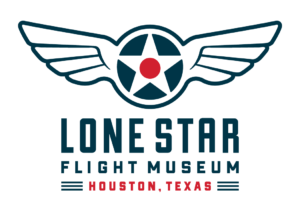 The single BIGGEST survey request, every year, is vintage warbirds. Some of the most immaculate vintage warbirds at the CAF Wings Over Houston Airshow come courtesy of the Lone Star Flight Museum.
The single BIGGEST survey request, every year, is vintage warbirds. Some of the most immaculate vintage warbirds at the CAF Wings Over Houston Airshow come courtesy of the Lone Star Flight Museum.
In September 2017, the Lone Star Flight Museum moved to the Ellington Airport. This Insider email features the Lone Star Flight Museum and some of their most prestigious aircraft.
About Lone Star Flight Museum
The Lone Star Flight Museum (LSFM) opened the doors of its new $38 million, 130,000 square-foot aviation history and STEM learning facility in the fall of 2017. The world-class facility shares the story of flight in the Lone Star State and features the contributions Texas and Texans have made to aviation. Highlights of the museum include the Texas Aviation Hall of Fame, the Museum’s renowned flying collection of historic aircraft, the $1 million, high-tech Aviation Learning Center and dynamic hands-on exhibits. Aircraft on display includes the museum’s B-17, B-25, DC-3, P-47, SBD, F4U, TBM, T-6 and Stearman, along with many other visiting aircraft.
Here are some of the Lone Star Flight Museum aircraft that will be featured (both flying and on the ground) at the 2019 Wings Over Houston Airshow.
SBD Dauntless
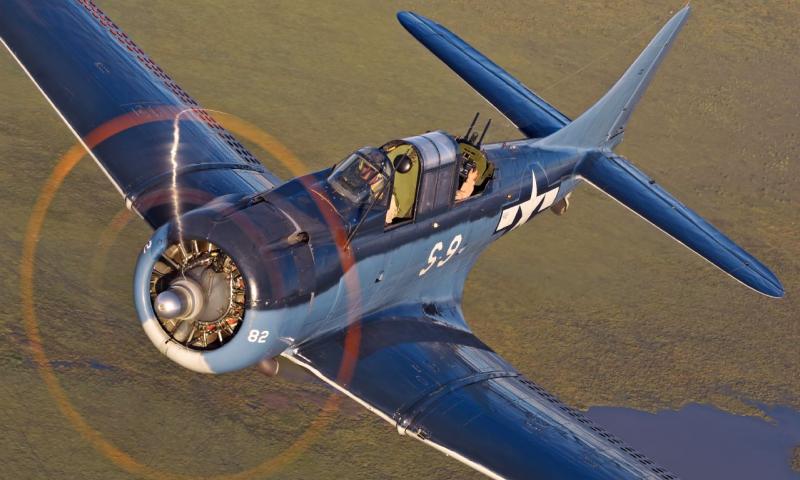
The SBD (Scout Bomber Douglas) Dauntless was derived directly from the Northrop BT-2 design of 1935. After Northrop became a subsidiary of Douglas, the new aircraft took on a Douglas designation. First orders for the SBD-1 and SBD-2 were placed by the Marine Corps and the Navy respectively on 8 April 1938, both entering service near the end of 1940. In March 1941, the SBD-3 was introduced, featuring protective armor and a more powerful engine than its predecessors. Armament consisted of two .50-inch machine guns fixed forward on the engine cowling and twin 0.30 inch machine guns manned by a second crewman for protection astern. Simultaneously, Army Air Corps’ interest in the design led to additional production orders, those in Army service designated A-24 and nicknamed “Banshee”. The SBD-5 (A-24B) followed soon after, its principal characteristic being a further engine upgrade.
B-17 Flying Fortress
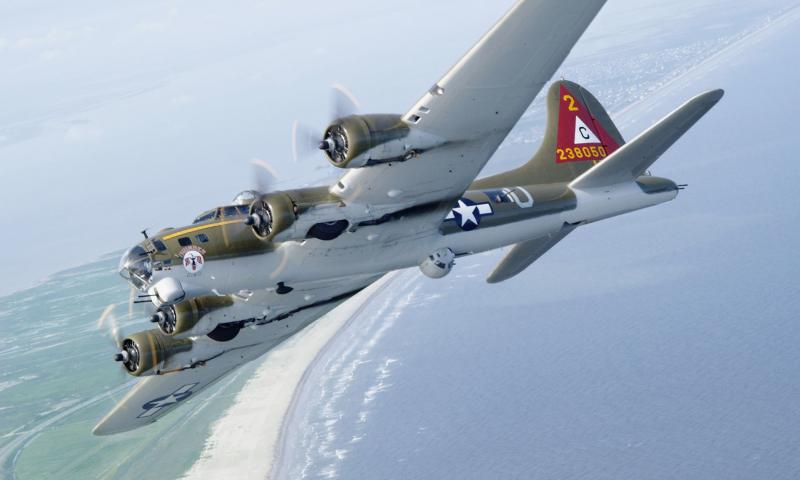 Perhaps no other aircraft more epitomized the air war against Nazi Germany than the Boeing B-17 Flying Fortress. While British bombers struck during the night, the legendary B-17 led the Allies’ daylight strategic bombing effort against Hitler’s Fortress Europe, conducting a twenty-four hour campaign to destroy Germany’s war-making ability.
Perhaps no other aircraft more epitomized the air war against Nazi Germany than the Boeing B-17 Flying Fortress. While British bombers struck during the night, the legendary B-17 led the Allies’ daylight strategic bombing effort against Hitler’s Fortress Europe, conducting a twenty-four hour campaign to destroy Germany’s war-making ability.
Fairchild PT-19 Cornell
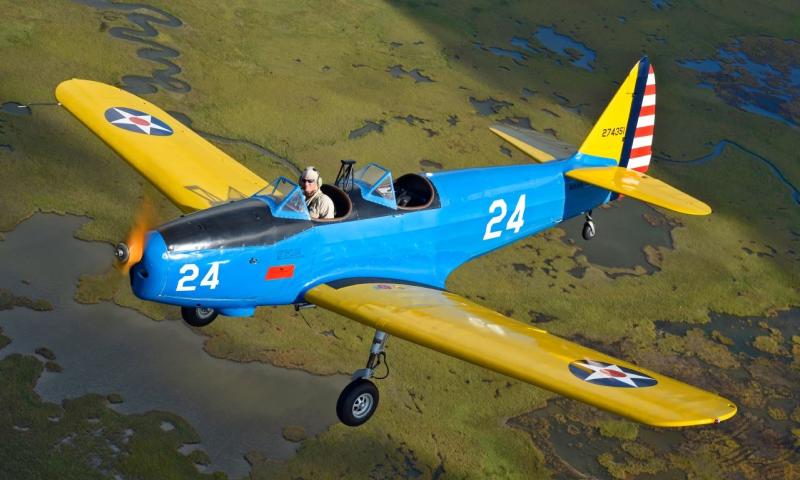
In the late 1930s, the Fairchild Aircraft Manufacturing Company entered their M-62, later known as the PT-19 design to satisfy the Army Air Corps’ call for a primary trainer. Among its refinements are excellent forward visibility and widely spaced fixed landing gear which guarded against ground accidents. The steel tubing frame and plywood covered wing and tail structures were light, strong and easy to maintain. As production increased, Fairchild began fitting Continental radial engines to PT-19 frames, calling the new aircraft the PT-23. Fairchild also produced the PT-26, a modified PT-19 featuring a fully enclosed canopy for the Royal Canadian Air Force to help combat the cold Canadian climate. By the end of the war, a total of 8,130 PT-19s, PT-23s and PT-26s had been produced.
P-47 Thunderbolt
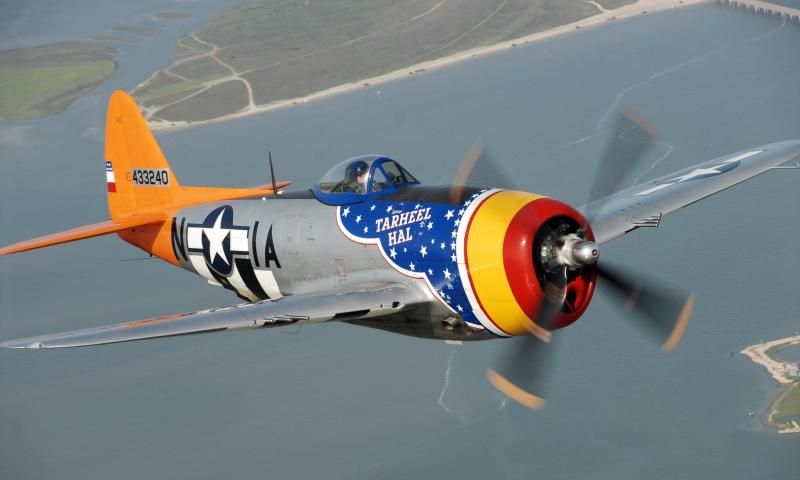
The Thunderbolt was the brainchild of Republic Aircraft’s chief designer, Alexander Kartveli. His challenge was to meet a 1940 Army Air Corps demand for a high speed, high altitude fighter with immense firepower. Republic had been developing the P-44, follow-on to its P-43 Lancer, but Kartveli realized it would fall far short of Army requirements. Kartveli molded the P-43’s lines into a new design patterned around the V-block Allison V-1710 engine. It later became clear that the new fighter, designated P-47, would never reach its potential with the under-powered Allison and it was replaced with a Pratt & Whitney R-2800 Double Wasp radial mated to a turbocharger for high altitude performance. To take advantage of the powerful R-2800, Republic fitted an immense four-bladed propeller. With an armament consisting of eight .50-inch machine guns, maximum speed of well over 400 mph, and a maximum ceiling of 40,000 feet, the Thunderbolt was just what the Air Corps was looking for in a fighter.
T-6 Texan
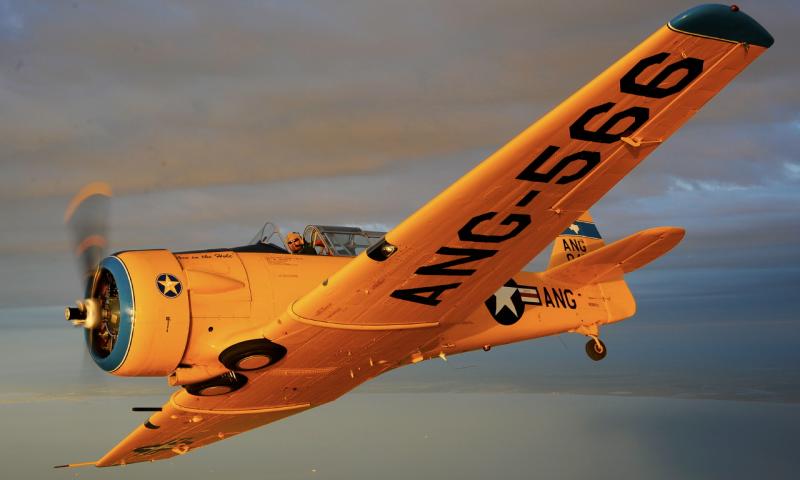
The North American T-6 Texan was known as “the pilot maker” because of its important role in preparing pilots for combat. The T-6 was the classroom for most of the Allied pilots who flew in World War II. The T-6 trained several hundred thousand pilots from the United States and many other countries for over three decades. A total of 15,495 of the planes were made. Although not as fast as a fighter, it was very manueverable and challenging enough to fly making it a great transition aircraft for the powerful and sophistacated fighters that would follow. The AT-6 was easy to maintain and repair and allowed pilots to train in all types of tactics, from ground strafing to bombardment and aerial dogfighting.
B-25 Mitchell
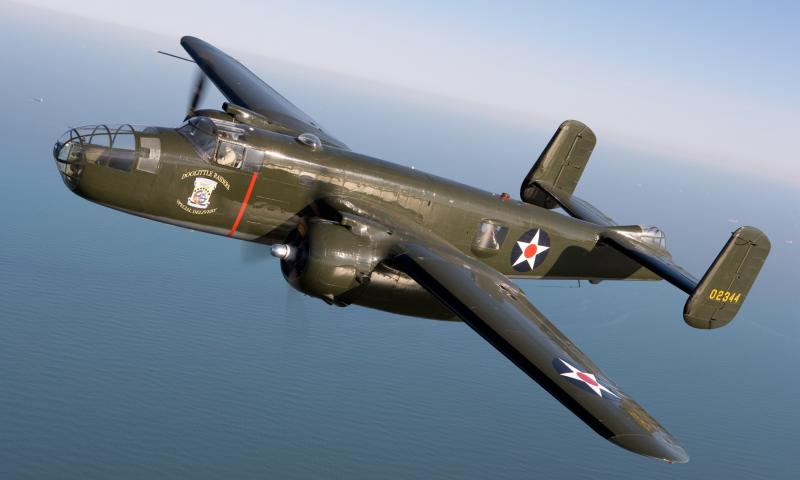
North American Aviation’s design of a twin-engine medium bomber was approved by the Army Air Corps in September 1939, and the prototype made its maiden flight less than a year later on 19 August 1940. Christened Mitchell in honor of Billy Mitchell, the American champion of air power theory, the B-25 would become the most widely-produced American twin-engine combat aircraft of World War II.
PT-17 Stearman

From 1934 until February 1945, the Stearman Aircraft Company, a division of the Boeing Aircraft Company, built a total of 8,428 model 75 airplanes for the U.S. Army and U.S. Navy for use as primary trainers. During this 11-year span, more American military pilots learned to fly in the Stearman model 75 primary trainers than any other airplane. The Army and Navy both used the trusty Stearman where they were referred to primarily as a PT-17 with the Army and a N2S-3 with the Navy. Although the Stearman was challenging to fly in the hands of a student pilot with no previous experience, it allowed instructors to quickly evaluate student performance and move those who were not progressing into other jobs. Made primarily out of wood and fabric with a steel tube fuselage, the Stearman was one of the strongest trainers built during World War II. After the war, many Stearmans soldiered on for decades as crop dusters and air show performers. The remaining examples of this classic aircraft are now sought by collectors worldwide.
F4U Corsair
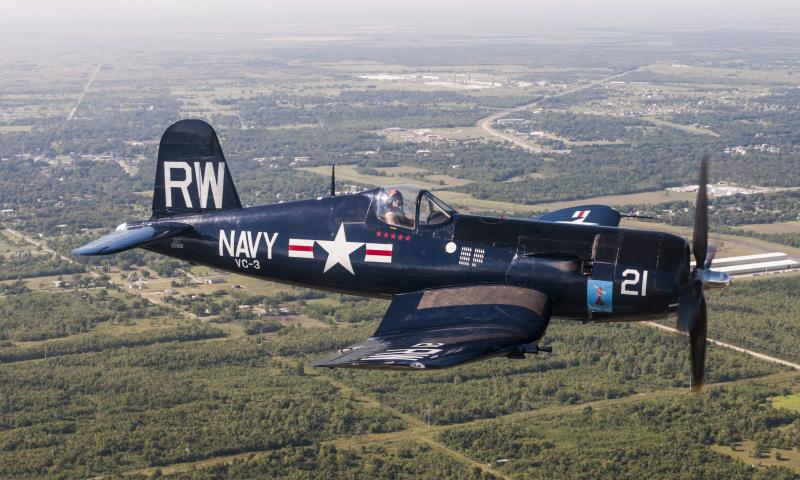 Chance Vought Aircraft Corporation contracted with the US Navy for a single prototype fighter aircraft in June 1938. Vought engineers selected the new 2,000 horsepower Pratt & Whitney R2800 engine for the project that would become the Corsair. The powerful engine required a large 14-foot diameter propeller, which necessitated changes in the design to assure ground clearance was met during carrier landings. These changes gave the Corsair its distinctive inverted gull wing shape by placing the landing gear at the lowest point on the wing making the gear more compact and robust. The Corsair made its maiden flight on 29 May 1940 and later became the first American fighter to exceed the 400-mph mark.
Chance Vought Aircraft Corporation contracted with the US Navy for a single prototype fighter aircraft in June 1938. Vought engineers selected the new 2,000 horsepower Pratt & Whitney R2800 engine for the project that would become the Corsair. The powerful engine required a large 14-foot diameter propeller, which necessitated changes in the design to assure ground clearance was met during carrier landings. These changes gave the Corsair its distinctive inverted gull wing shape by placing the landing gear at the lowest point on the wing making the gear more compact and robust. The Corsair made its maiden flight on 29 May 1940 and later became the first American fighter to exceed the 400-mph mark.
Photo and Information Credits:
Lone Star Flight Museum
Get More Information on Lone Star Flight Museum:
SAVE UP to 22% OFF* Airshow Tickets when you BUY ONLINE! Ticket Prices increase this Friday, October 18th at 11:59 PM CT.
Please note: Your Insider ONLY discount is automatically applied to any tickets you select during the checkout process. The prices you see in the cart are the INSIDER ONLY discounted prices.
Please note:
Aircraft and performers are subject to change without notice, due to operational considerations. If anything changes, we will do our best to let you know. Thank you!
Your Privacy & Personal Information
The security of your personal online information is paramount to us! We attempt to go above and beyond to protect your online identity when using this web site or purchasing tickets to the Airshow. Any user information collected will be used for the purposes of giving you airshow updates, marketing the airshow, and selling tickets to the CAF Wings Over Houston Airshow. Your information will NEVER be sold or rented to any third parties. For additional privacy information details, please review our privacy policy.

